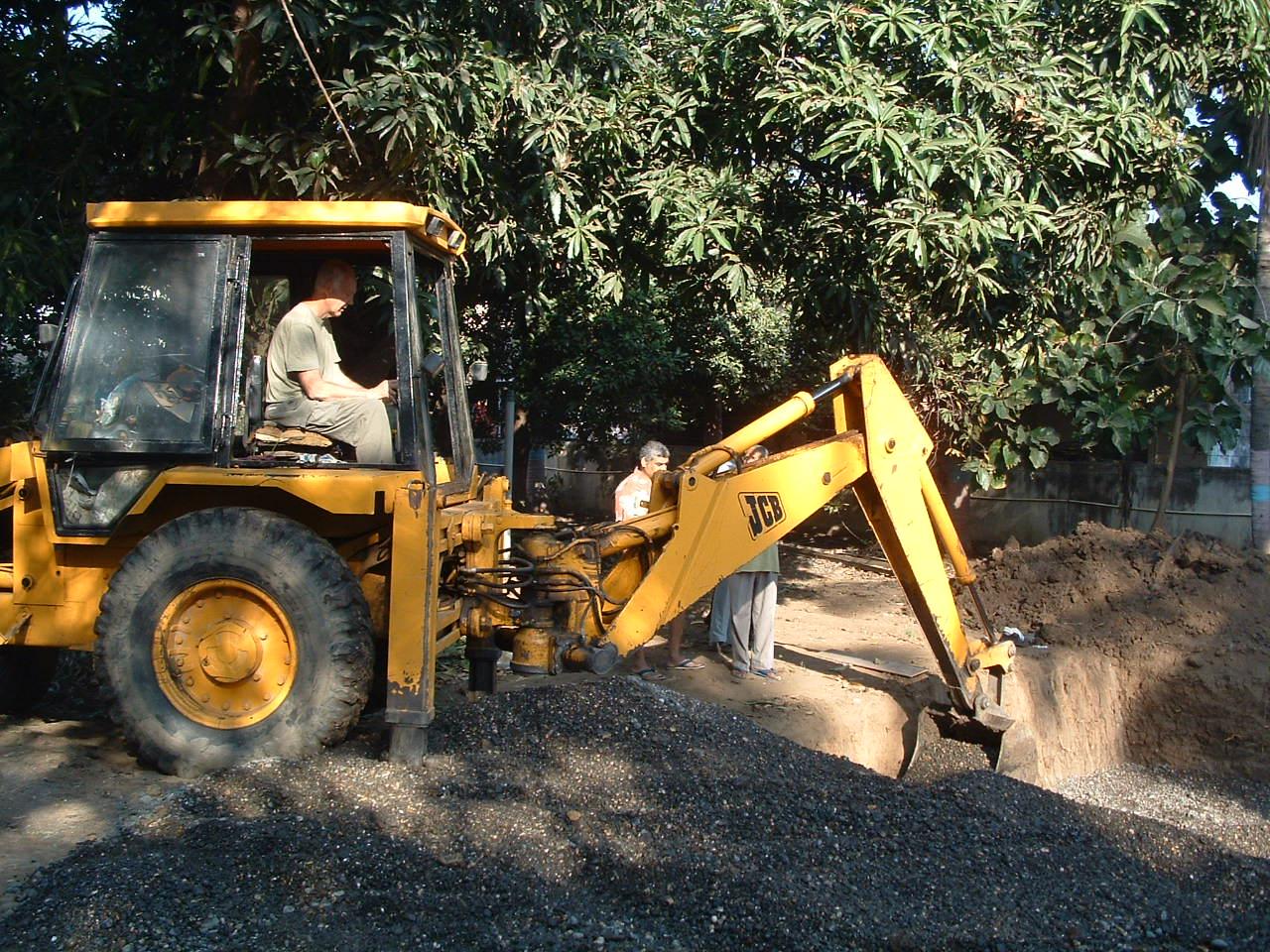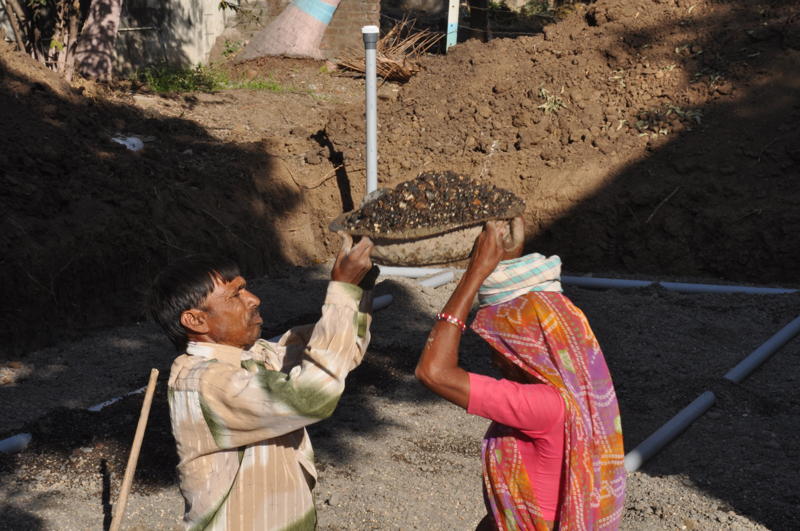Constructing a Septic System in India
As an excavating contractor and building a multitude of leaching fields over the years, I thought I knew just what size machines, the type of crushed stone required and the minimum selection of tools necessary to build a septic system.
.jpg)
(The JCB operator always had plenty of willing local riders)
If someone had tried to tell me I could do this task with less, I would have thought they had never done this work before or were seriously misinformed. In Nansad, India, however we had to throw away the book on these western standards. To work with a short handled grub ax shovel, an aluminum pan supported by your head, carrying sediment stone mined from the river and...
_(2).jpg)
(We engineered the systems with a hand level and a stick)
...a backhoe that could qualify for antique plates, required imagination and creativity beyond what we knew possible, to build our two septic systems.
.jpg)
(Mining gravel from the polluted Tapi River. Not a fish in sight)
Part of our training there was to learn the translations of the Indian business practices. The first and most important concept to learn was: Yes, I will be there in the morning. Local translation: At noon or sometime in the afternoon. When we have not shown up yet, call again and try for tomorrow morning.
.jpg)
(Gravel trucks, arriving at 10:00 pm at night as Paul was hard on those arriving during the day)
We are still not sure about this one; When you ask a question like “Can you get this pipe?”, you immediately get a gathering of several Indian people who enter into a dialogue with their voices continually rising in decibel level until you think they are mad at each other. After ten minutes of this shouting match, they stop. You ask,”Do they have the pipe?” ” Oh, they don’t know yet. They have to call. “
.jpg)
(When the JCB was a no-show, everyone helped move the gravel)

(After an exercise in patience, Herb gives a lesson in the USA way of operating a backhoe)
I guess the one that brought me to my spiritual knees was asking the backhoe operator to do something my way. Trying several times through sign language and an interpreter to make this happen, there was absolutely no change in procedure. Translation to the instructions: We have been doing this for a thousand years and we are not going to change now.
.jpg)
(Moving gravel like the locals. Unfortunately this man was not happy with 100 Rupees a day)
The other shocking difference in Indian construction protocol is the enormous effort of human labor. Forget a backhoe. Three or four good aluminum pans with Indian women in colorful saris under them, and you are moving some material.
.jpg)
(Heading off in the morning, with supplies for the school system)
.jpg)
(with a little help from our friends)
.jpg)
(Plastic water tanks served as septic tanks)
.jpg)
(A little carried away hammering out an old pipe...and splash...I had to hose myself down)
We had a tremendous effort from all those involved to complete our leaching field tasks in the time frame and conditions we had to work with. We were involved with some wonderful people in the process. Our living accommodations were superb. Meeting the kids each morning with handshakes and smiles of good morning greetings felt like we were important dignitaries. We learned some new basic construction standards and did some work under the lights… that is, flashlights.

(moving gravel, Indian style. Husband shovels, wife totes.)
.jpg)
(The system at the school is almost completely backfilled - by hand)
Although solving the sewer and water issues in India is a giant project analogous to heating the North Pole with a candle. it felt good that we had made a contribution, however large or small, to improve the health standards in the village. I am grateful for the opportunity to help. It was a satisfying and wonderful experience.
.jpg)
(A gentle reminder of the country that tried to help a little)
Hello Mannie. Sorry we missed you. Herb and I were happy to contribute to Arjun's goal of cleaning up Nansad.
Paul Saulnier | 2011-03-27 03:54:36
Only one word comes to mind WOW !!! I may have invited you guys for scrambled eggs on toast or cornflakes for breakfast. I was in Nansad, only if I had known you were living two doors down the road. You have done wonderful job for the kids of primary school. Your contribution is immensely valued.
Mannie | 2011-03-26 18:32:09
any chance we could adapt this technique to soggy mudville? Great work, guys. thanks for demonstrating the best of our "foreign policy"
Pat Fuller | 2011-02-25 19:00:03
What a great experience and demonstration in humanity. You are truly a 'difference maker' in the world, Paul. Putting the well being of these children and village before your own. A wonderful teaching (and learning)experience for all of us.
Admirer | 2011-02-24 12:01:39
Thanks for the kind words. It may sound corny but Herb and I got much more out of the work than the town of Nansad.
Paul Saulnier | 2011-02-22 09:29:49
Everyone wins in this article. Thank you to Herb and Paul, and to the others who do this kind of work - Engineers Without Borders - for your good effort in India, and for sharing this reality with us in Holliston - with such good humor too. Having stayed in developing countries, I've always been aware that clean (and hot running!) water is actually a luxury. In these times of growing insecurity and incivility at home and abroad, I am especially thankful that we still have people who are willing to, as you say, "try to help a little." You left "USA" carved in the concrete, but also in the health and the hearts of Nansad's people. To step out of the I've-got-mine comfort zone and share with others who need the most elementary basics for survival: that's a worthy endeavor. There are others in town who do it, and I hope the model of this article will encourage more sharing.
Grateful in Holliston | 2011-02-22 09:08:02